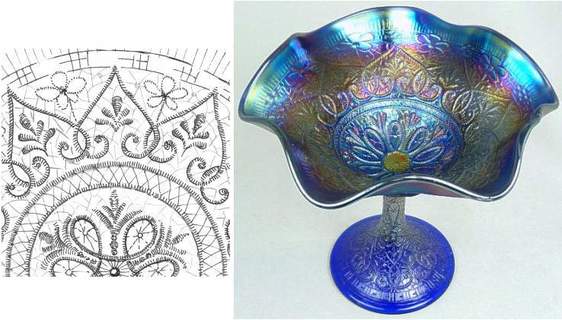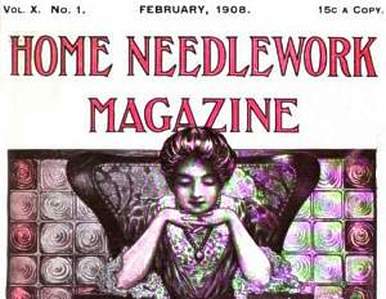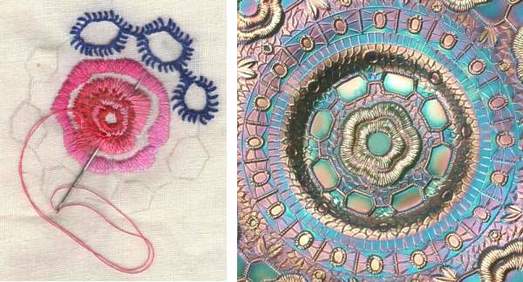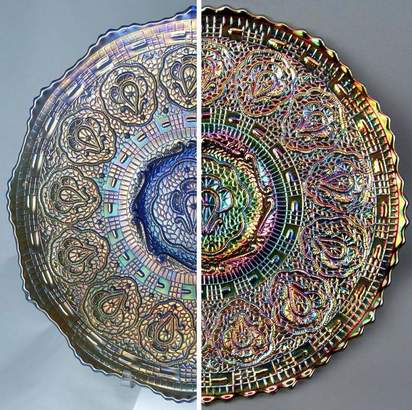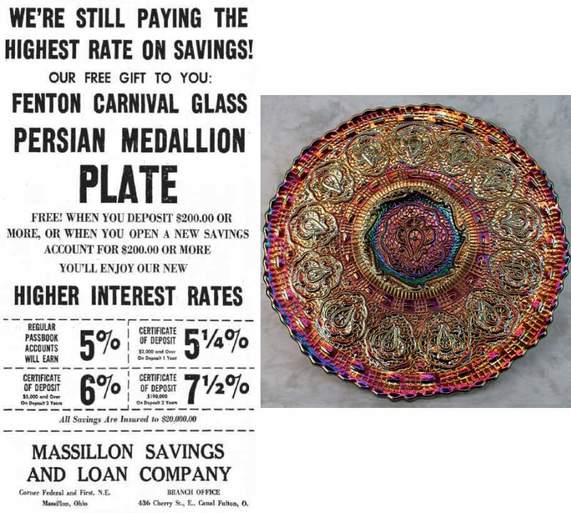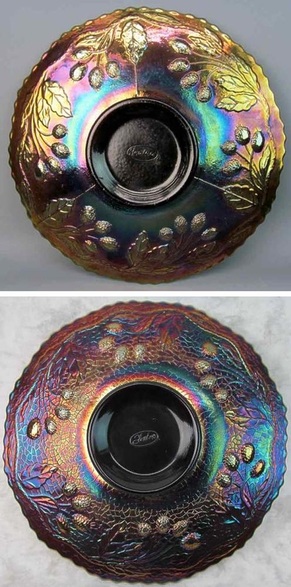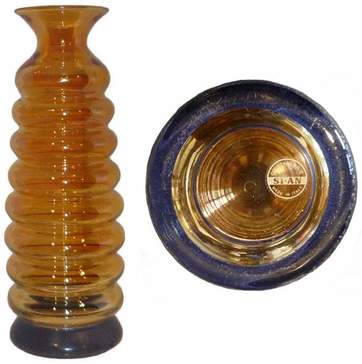NetworK ezine Issue 9. February 2016
by Glen and Stephen Thistlewood
A question that gets asked frequently: What is Carnival Glass?
The straightforward answer is that it is iridised, moulded glass that has a pattern.
The patterns are both fascinating and amazingly varied: what is astounding is how the makers went into overdrive to come up with new ideas for pattern designs. Flowers, birds (especially peacocks!), foliage, fruits and geometric patterns all flourished.
The straightforward answer is that it is iridised, moulded glass that has a pattern.
The patterns are both fascinating and amazingly varied: what is astounding is how the makers went into overdrive to come up with new ideas for pattern designs. Flowers, birds (especially peacocks!), foliage, fruits and geometric patterns all flourished.
|
What is less well known is that some of the very popular Carnival patterns were inspired by needlecraft - embroidery and lacework.
It was a ground-breaking, design innovation that worked so well because of the way these patterns responded to iridescence. The shimmer and contrast on the moulded patterns makes the designs stand out perfectly – from silken fabrics into glistening glass - with amazing designs like Northwood's Hearts and Flowers, on the right. Needlecraft of all kinds was very popular with girls and women of all ages, not just as a hobby but also as a way of furnishing the home and being fashionable. Surely the glassmakers' wives provided some of the initial inspiration to use needlecraft designs on Carnival! Imagine the scene … She’s working on a lace centerpiece for the dining table, or perusing the latest issue of the “Home Needlework Magazine”. He looks over her shoulder. That’s it … embroidery style roses, lacework motifs and more … transferred from hand-made needlework stitches to the cuts of the mould maker’s tools. |
By creating designs in glass that looked like needlecraft, the Carnival makers recognised a popular theme that would have instant appeal.
Did you recognize the floral motif (above, right)?
It’s from Fenton’s Captive Rose pattern, and we also show how the motif looks in actual embroidery stitches. The rose itself is satin stitch and blanket stitch is used around the hexagons. There are also two other needlecraft motifs on the pattern: buttonhole bars and the needle lace "filler" pattern.
Read the full article on our website and discover the secrets behind some of the amazing Carnival Patterns Inspired by Needlecraft.
Some may just surprise you!
It’s from Fenton’s Captive Rose pattern, and we also show how the motif looks in actual embroidery stitches. The rose itself is satin stitch and blanket stitch is used around the hexagons. There are also two other needlecraft motifs on the pattern: buttonhole bars and the needle lace "filler" pattern.
Read the full article on our website and discover the secrets behind some of the amazing Carnival Patterns Inspired by Needlecraft.
Some may just surprise you!
Persian Medallion - Classic and Contemporary.
|
Persian Medallion was undoubtedly a very popular seller for Fenton in Classic Carnival: the pattern appears regularly in wholesale catalogues from 1911 through to 1924. So, it is probably not surprising that this was one of the patterns that Fenton chose to reissue when they revived Carnival glassmaking from around 1970. On the right is a composite picture showing a Classic Persian Medallion plate on the left, and a Contemporary plate on the right. Both are sumptuous examples of their genre. |
|
Below is an amazing ad from 1971, for the Massillon Savings and Loan Company, offering a Contemporary Fenton Persian Medallion plate for customers making a $200 deposit. This clearly establishes the timing of the re-introduction of the pattern in the early days of their Carnival Glass revival. |
Above: Two versions of Bearded Berry on the exterior of the contemporary Persian Medallion plates.
|
The old, Classic Persian Medallion bowls and plates mostly have a plain exterior while the Contemporary pieces feature a modern version of Fenton’s Bearded Berry design. The photos above, right show the two versions of this: one with a “netting” or a needlework effect behind the berries, and one without.
All the splendid photos of Contemporary Persian Medallion plates are courtesy of King Hoppel.
Read more about Persian Medallion, a Fenton Masterpiece.
The Fenton logo.
The Contemporary pieces are also marked with the Fenton Logo on the marie (i.e. the base). It was a specific commitment by the late Frank Fenton, that Fenton would mark their Contemporary Carnival Glass, an undertaking achieved in part thanks to the efforts of Carnival Glass pioneer Rose Presznick. We have the story of how this assurance - crucial to Classic Carnival collectors - came about.
Read it here: The Presznick Carnival Glass Museum.
|
A Melon Rib Vase with a Difference
John Hodgson reports this breathtaking “Melon Rib” style vase - his research on it is fascinating. John takes up the story for us: “When I saw this melon-rib-style vase on a market stall, I could hardly believe my eyes. The rich, marigold iridescence is top notch and I was surprised that it had not already been snapped up. On closer inspection, it looked as though the vase had been affixed to a heavy stone base, but it turned out to be a thick layer of varnish applied to the bottom rib. It has a heavy base with a small amount of wear, so it does not appear to have a lot of age. The biggest surprise, though, is the label affixed to the bottom of the vase, indicating that it was made by ‘Cristallerie SI-AN’ and that it was ‘Made in Italy’. I cannot find much information about SI-AN, on line, but they appear to still be in operation. ore research needs to be done, but my feeling is that the vase is probably a late 20th. century piece.” Thanks to John for the photos of this most unusual item. |
Finally, we wish to pay tribute to the late Fred N. Stone, who passed away on January 17th. A dear friend, Fred was co-founder of the internet club, wwwcga, and we worked with him for many years. He will be greatly missed by so many, in all walks of life. RIP Fred Stone.
Missed any issues of NetworK? They are on our Back Issues page


